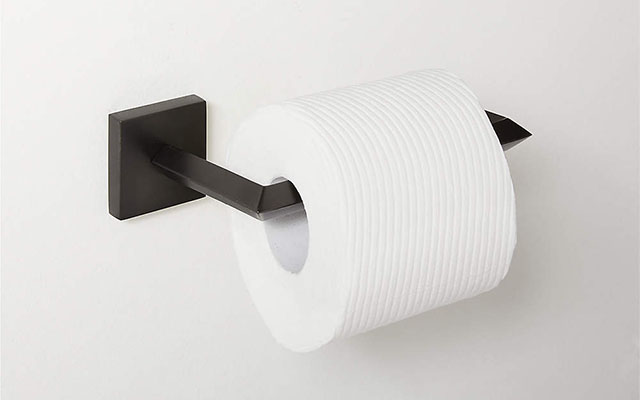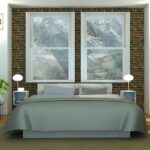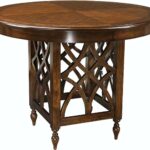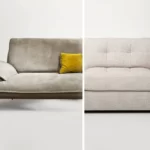The average height of a backrest-equipped bench ranges from 30 to 36 inches. Anyone can sit comfortably on a bench because it ranges in depth from 15 to 20 inches. The standard bench length can vary depending on the seats, but the average sizes are:
- 2-seat bench— 42 to 52 inches wide
- 3-seat bench— 53 to 80 inches wide
- 4-seat bench— 81 to 96 inches
Which bench sizes are typical for the dining room, bedroom, mudroom, shower, and deck? The dimensions and typical sizes for the various rooms in your house will be covered in this guide. Learn more by reading on.
Table of Contents
The Standard Size of a Bench
These sizes are averages or “standards” manufacturers use when constructing a bench. The size of your bench ultimately depends on where you’ll put it, even though the average bench size is commonly used.
The size of the bench also depends on your preferences, requirements, and what you find to be comfortable. However, the standard bench sizes according to usage are listed below.
For Decks
Outdoor or deck benches come in a variety of sizes, but most are small. Finding the ideal fit for you is essential. Having the proper measurements ensures that the bench will be used for more than just decoration, whether you prefer a free-standing bench or one that is built into the deck already present.
The standard size for outdoor benches is:
- A height of between 18 inches through 20 inches (assuming you have a 19-inch to 30-inch high standard table)
- Depth is about 12 inches to 15 inches
- Some deck benches can be up to 20 inches wide, providing more surface area.
Cushioned deck benches are about an inch shorter. When people sit down, this accounts for an inch of compressed cushion to stop knees from contacting the underside of the table.
For Dining
Regardless of whether your dining space is informal or formal, a dining bench is a wise choice. By pairing with dining chairs, for example, the bench enables a more flexible seating configuration. The standard size for a dining bench is:
- Length— between 42 and 60 inches
- Depth— Between 12 inches to 23 inches, but there is no standard for this
- Height— At least 12 inches lower than your tabletop and between 18 and 20 inches tall.
For Mudrooms
You can take off your muddy boots and wet clothes in the mudroom, which serves as a secondary entrance. You can sit down and take off your boots on a bench in the mudroom.
Additionally, it can give you storage space. You must be aware of the standard dimensions when choosing a mudroom bench. You can be certain that it will fit if you do it this way. The standard mudroom bench is:
- 18 inches high
- Between 36 to 48 inches wide
- About 14 to 17 inches deep
For the Shower
An extravagance could be a bench. However, for some people, it is essential. For people who find it difficult to stand for an extended period of time or when you’d rather unwind and enjoy the steam from the shower, a bench is an option. The typical shower bench is:
- Between 17 to 20 inches high
- 15 to 16 inches deep for a comfortable space to rest in the shower
- The duration may change based on the size of your shower.
For Decks and Tables
Height: Standard bench height for decks and outdoor benches is typically between 18″ and 20″. Remember that this assumes the table for which you are building the benches is around 29 to 30 inches high, which is the typical height for tables.
Width (or Depth): About 12″-15″, or about three deck boards wide depending on the depth you’re hoping to achieve. If you need a little bit more surface space, you might want to go as wide as 20″.
Tips from pros:
- Leave space for trim, of course!
- Build the benches 18″ high for shorter clients in accordance with their height. Reach a height of 20′ Prime for clients who are taller.
- Consider keeping the bench about 12 inches lower than the table.
- If there will be cushions on the bench, leave about an inch or so between them and the underside of the table so that when people sit on the cushions and they compress, that inch of compressed cushion is taken into account.
For a Workbench
Height: standard ranges from 33&Depending on your height and preferences, the height ranges from Prime; to 36 Prime.
Pro tips:
- the people at Woodworking tips advise measuring the distance between the floor and the point at which your wrists bend to determine the ideal height for your bench. (Thanks for the tip!)
- adjust as needed, to your liking.
For Your Bedroom
A bedroom bench, also referred to as an end-of-bed bench, adds functionality while bringing your space together. The bedroom bench is perfect for placing your decorative pillows for the night as well as serving as a half step or point for animals who have trouble jumping into your bed.
In relation to the size of your bed, the bench’s width should be appropriate. For instance, queen beds should be 45 inches long, and king-size beds should be between 60 and 65 inches long. Verify that the bench does not protrude out from the bed on either side.
A bench at the foot of the bed ought to be a few inches shorter than the bed. If your bed has a footboard, however, you can choose the same height. How deep your bench should be depends on how much room you have on each side of the bed. In case your room is small, choose a narrow bench.
The Standard Depth of a Bench Seat
Generally speaking, seats should be between 16 and 20 inches tall and 18 inches deep. If backs are offered, they should be at least 14 inches high, reclined, or otherwise shaped for comfort. Seating provided on planter ledges must be at least 22 inches deep to accommodate generous plantings.
The Best Angle for the Back of a Bench
100 to 110 degrees is the ideal angle between the seat and the backrest. You should have enough room at the bench’s base to bring your feet back close to your body. Your quadriceps will be more at ease in the sitting position when your knees are bent at an angle less than 90 degrees.
How to Measure Your Space for a Bench Seat?
The final step before making a purchase is to measure up when you’re ready to make the commitment. Make sure your area will accommodate your chosen bench with room to spare and be able to move around in it.
Wherever you’re placing your bench seat, the most important factor to consider is clearance, from both other furniture items and the walls in the space. Try to leave at least 30cm from any other smaller furniture pieces, or 50cm from big items like sofas and entertainment units. This rule obviously won’t apply if you’re using your bench as an ottoman. The same holds true for your room’s walls, especially if you’re measuring for a dining bench. Aim for a distance of at least 60 cm between your bench and the surrounding walls to allow for pulling the seat out after a meal.
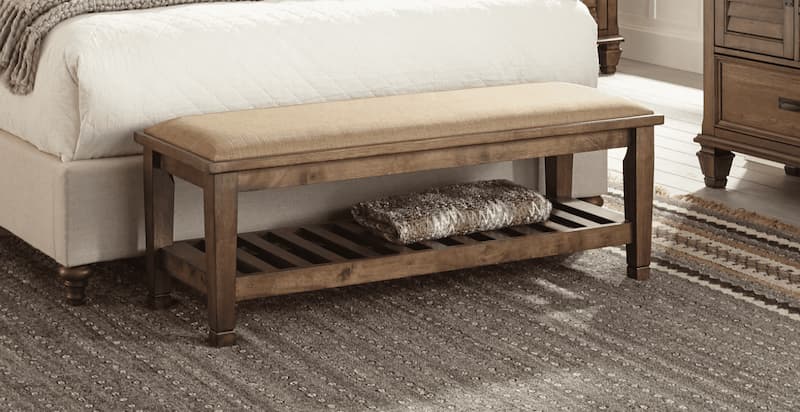
Considerations for Choosing a Bench
Looking for a bench? Choose the right one is easy when you consider these factors:
- Where you are placing it— Depending on the design of the room and the number of seats needed, you have a few options. Small dining spaces can be maximized by placing a dining bench with its back against the wall. If you’re seated at a corner table, a corner bench with a back is ideal.
- The space available— If you want a bench that you can tuck under a table, choose one without a back. Make sure the bench is 2 to 4 inches shorter than the distance between the table legs.
- With back or without— The likelihood of slouching is decreased by benches with backs that you and your visitors can lean against. An adaptable piece of furniture that contributes to a casual atmosphere is a backless bench.
- The number of people seating— Take into account the number of occupants in your home and any frequent visitors. For two adults, a bench that is 42 to 52 inches long is appropriate; longer benches offer at least 21 inches per person.
- The material— For outdoor use, wicker and plastic models work best, whereas richly colored wood benches are best for cozier settings in your living room or bedroom. Velvet gives off a fancy, opulent appearance, and leather benches are relatively water-resistant and simple to clean.
- Storage space— Look for a storage bench with a flip-top or hinged lid if you want to conceal your clutter. When you need quick access to your possessions, a bench with cubbies or shelves is preferable.
- Your decor style— Finally, despite how lovely it is, don’t consider your bench to be a separate component. Make sure it blends in with the rest of the space and maintain some consistency in terms of material, color, and finish. Traditional, contemporary, cottage, and modern styles are among the many available.
The Pros of Bench Seating
If you’ve simply dealt with chairs your entire life, you might be wondering ‘what’s so good about a bench?’ Look around at your favorite eateries, shops, outdoor areas, and more. Benches are virtually ubiquitous, and this is largely due to their ability to be customized to meet a variety of requirements. A bench can be put to good use in almost every room of your house, serving as anywhere from a place to put your shoes to seating for a casual outdoor dinner.
Although there was only one kind of bench available in the past—it was wooden, uncomfortable, and not particularly attractive—there are now a variety of bench seating options. They’re therefore more cozy and aesthetically pleasing than ever.
Popular Bench Seating Styles
Consider the most popular designs and finishes before deciding to add a bench to your interiors if you’re keen to do so. In order to fit a variety of spaces and uses, we’ve selected five of our favorite bench seats. Let’s get started!
- Mod dining, sorted
Turn your dining room into a mid century modernparadise with the sleek lines and gorgeous curves of the Coltrane Bench. Rich dark chestnut and light, unfinished beech wood are the two available finishes for this wooden bench seat. Its exaggerated lines are a visual feast in any room, and it can worry-free seat enough guests for a dinner party. As is typical for a bench seat, it is a multipurpose item that would look great as a practical seating area in a hallway or bedroom. - The epitome of easy outdoor living
If the idea of a one-and-done outdoor piece that provides ample seating and surface area appeals to you, look no further than the Smeaton Outdoor Dining Table and Bench Set. It’s easy to furnish your garden, courtyard, deck, or patio with the help of this setting, and best of all, it’s done in style! The industrial look that contemporary cement and black metal produce will look stunning when set against the natural vegetation. - A touch of coastal charm
Rattan is a material that has gained popularity and shows no signs of slowing down, so we had to include a bench seat made of this lovely, textured wood in our list. The Caledonia Rattan Benchseat is constructed using sturdy mango wood and a rattan tabletop surface that adds depth and a little coastalflair. The ideal spot for this bench would be at the foot of a wooden bed. You could also use it to divide a room in half; place it behind the sofa for simple division. Although it’s not packed with storage, you’ll be able to pop your favourite decor items on the top for a lovely look that’s full of personality. - Storage made simple
Sleek and chic, the Sara Storage Ottomanadds a plush seat to any room, with soft grey upholstery that will blend right in with a variety of styles, from modern contemporaryto Scandinavian and beyond. The real selling point, however, is its generous storage. Just flip the lid to reveal tons of room for items that need to be tucked away, such as linens, blankets, and other things that don’t have a regular home. The Sara Ottoman can be added to any hallway or positioned at the foot of your bed. - Provincial, practical and pretty
If you’re looking for a piece that blends form and function, the Petite Fleur Ottomanwill be a fast favourite. Made out of super-solid oak, the base has a rustic wooden look in line with this beautiful, French provincialstyle. The seat is then covered in the softest, most luxurious upholstery, which has a chic tufted appearance that will add a touch of luxury to any space. While you adorably perch on the seat, arrange your favorite items on the shelf below. This bench is ideal for storage and for use as a seat.) your shoes in the hallway or bedroom.
A bench seat or ottoman is sure to be a wonderful addition to your home, one you will long to have had, regardless of your decorating preferences or where you place it. Shop our full range of beautiful and functional bench seats for the dining room, bedroom, living room, hallway and more and experience the Brosa difference.
Frequently Asked Questions
Are There ADA Size Requirements for Benches?
Take into account the ADA size restrictions to ensure compliance and prevent offending family members and visitors. Transferring from a wheelchair to a bench is made simple by the ADA and ABA Accessibility Guidelines for Buildings and Facilities’ suggestions.
Section 903 suggests a bench should have the following measurements to be accessible to everyone:
- A seat height of between 17 inches to 19 inches from the ground;
- The seatback should extend the bench full length;
- Employ an arm-supported bench.
What Should You Look for to Ensure Comfortable Seating?
To avoid leg swelling, the ideal seat height should support a knee angle of 90 degrees. Increased pressure under the knees may result from a bench that allows you to hang your legs. It can also decrease blood circulation and increase pressure on the nerve.
If a bench has a back, you should be able to use it with the seat depth. A bench’s armrests help with sitting down and getting up by adding more postural support. While a medium-level backrest offers complete shoulder support, a low-level backrest supports the lumbar region.
The recommended backrest angle ranges from 100 to 110 degrees. The most important piece of advice is to test benches of similar sizes. Check to see how comfortable the bench is and whether your feet are resting comfortably on the ground. Test whether you can comfortably recline on the backrest as well.
Do Standard Bench Sizes Matter?
By understanding the typical bench dimensions, you can organize your space more effectively, put everything in its place, and determine the size of other items you’ll need for your garden, deck, or room.
To help you choose the best bench for your space, we’ve gone over the typical bench sizes in this guide. Check back here for a reference for all your sizing needs when you’re ready to buy your next bench.
Read about

